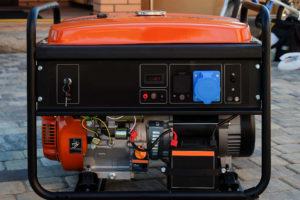Safe Use of Portable Generators
Portable generators are good to have on hand when the power goes out, but there are safety risks involved. Outlined below are specific hazards associated with the use of generators, along with tips on how to use them safely.

Shock and Electrocution
Portable generators are internal combustion engines used to generate electricity. The electricity created by generators has the same hazards as normal utility-supplied electricity. It also has some additional hazards because generator users often bypass the safety devices (such as circuit breakers) that are built into electrical systems. The following precautions can help reduce shock and electrocution hazards.
Never attach a generator directly to the electrical system of a structure (home, office, trailer, etc.) unless a qualified electrician has properly installed the generator with a transfer switch. Attaching a generator directly to a building electrical system without a properly installed transfer switch can energize wiring systems for great distances. This creates a risk of electrocution for utility workers and others in the area.
Always plug electrical appliances directly into the generator using the manufacturer’s supplied cords or extension cords that are grounded (3-pronged). Inspect the cords to make sure they are fully intact and not damaged, cut or abraded. Never use frayed or damaged extension cords.
Ensure the cords are appropriately rated in watts or amps for the intended use. Do not use underrated cords—replace them with appropriately rated cords that use heavier gauge wires. Do not overload a generator; this can lead to overheating which can create a fire hazard. Best practice is to use a heavy duty cord rated as 12 gauge AND outdoor use. You can also buy heavy duty cords with built in GFCI –see below.
Use ground fault circuit interrupters (GFCIs), especially where electrical equipment is used in or around wet or damp locations. GFCIs shut off power when an electrical current is detected outside normal paths. GFCIs and extension cords with built-in GFCI protection can be purchased at hardware stores, do-it-yourself centers, and other locations that sell electrical equipment. Regardless of GFCI use, electrical equipment used in wet and damp locations must be listed and approved for those conditions.
Make sure a generator is properly grounded and the grounding connections are tight. Consult the manufacturer’s instructions for proper grounding methods.
Keep a generator dry; do not use it in the rain or wet conditions. If needed, protect a generator with a canopy. Never manipulate a generator’s electrical components if you are wet or standing in water.
Never use electrical equipment that has been submerged in water.
Carbon Monoxide Poisoning
Carbon monoxide (CO) is a colorless, odorless, toxic gas. Many people have died from CO poisoning because their generator was not adequately ventilated.
Never use a generator indoors or in enclosed spaces such as garages, crawl spaces, and basements. NOTE: Open windows and doors will NOT prevent CO from building up when a generator is located in an enclosed space.
Make sure a generator has 3 to 4 feet of clear space on all sides and above it to ensure adequate ventilation.
When placing your portable generator outside, keep the generator a minimum of 15 feet away from any structure, including any doors or windows.
If you or others show symptoms of CO poisoning—dizziness, headaches, nausea, tiredness—get to fresh air immediately and seek medical attention. If symptoms are severe contact 911 immediately. Do not re-enter the area until it is determined to be safe by trained and properly equipped personnel.
Fire Hazards
Generators become hot while running and remain hot for long periods after they are stopped. Generator fuels (gasoline, kerosene, etc.) can ignite when spilled on hot engine parts.
- Before refueling, shut down the generator and allow it to cool.
- Gasoline and other generator fuels should be stored and transported in approved containers that are properly designed and marked for their contents, and vented.
- Keep fuel containers away from flame producing and heat generating devices (such as the generator itself, water heaters, cigarettes, lighters, and matches).
- Do not smoke around fuel containers. Escaping vapors or vapors from spilled materials can travel long distances to ignition sources.
- Do not store generator fuels in your home.
- Store fuels away from living areas.
Noise and Vibration Hazards
Generator engines vibrate and create noise. Excessive noise and vibration could cause hearing loss and fatigue that may affect job performance. Keep portable generators as far away as possible from work areas and gathering spaces. Wear hearing protection if this is not possible.
(Source: OSHA)

